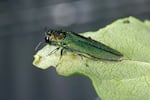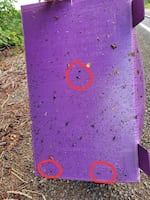
This provided photo shows the side view of an adult emerald ash borer. The invasive beetle is native to Asia and has killed more than 100 million ash trees in the U.S. since its arrival in 2002. It was first detected in Oregon in Forest Grove in June 2022.
James E. Zablotny/USDA APHIS
Invasive emerald ash borer beetles are threatening ash trees in three more counties across the Willamette Valley.
New detections reveal the metallic-green beetle, about a half-inch long, has made its way into Marion, Yamhill and Clackamas counties — miles away from the previously known infestations in Washington County.
The emerald ash borer came to the U.S. from Asia in 2002 and had already killed millions of ash trees across the country when it was first detected in Oregon in 2022 at a school in Forest Grove.
Experts say there is no way to stop the beetle from eventually killing most of the ash trees in Oregon, including the native Oregon ash. However, land managers have removed dozens of infested ash trees, treated healthy ash trees near the infestations with pesticide and hung hundreds of sticky purple traps in ash trees across the Willamette Valley to alert them as the invasion spreads. Last month, officials discovered traps in Yamhill and Marion counties with emerald ash borer beetles stuck to them.

Sticky purple traps have been hung throughout the Willamette Valley as an early warning system to track the locations of invasive emerald ash borer beetles. This trap was found in July in Marion County with several invasive beetles on it.
Courtesy of Oregon Department of Forestry
Wyatt Williams, invasive species specialist with the Oregon Department of Forestry, said the traps are part of a statewide strategy to slow the spread of the beetle, and the new detections show the early warning system is working.
The U.S. Department of Agriculture’s Plant Health and Inspection Service confirmed that the beetles found in Yamhill and Marion counties are indeed the emerald ash borer. The agency has not yet confirmed the species of the beetles found in Clackamas County.
Oregon’s first detection outside of Washington County was in Gaston, about seven miles away from where the beetle was first detected in Forest Grove, Williams said.
“So that was to be expected,” he said. “It wasn’t a big surprise.”
But Williams said the five beetles found in one trap east of Woodburn in Marion County were a surprise.
“These traps are not that effective,” he said. “So when we find that many beetles on a single trap, we know there is a significant population in that area. And when you drive around the area where the positive trap is, you would never guess that those trees are infested with emerald ash borer.”
Ash trees lose the ability to transport nutrients and water as emerald ash borer larvae eat the inner bark, so heavily infested trees will have visible dead branches.
But trees around the trap in Marion County were still green and lush, Williams said.
“Traps are working for early detection,” he said. “Because of them we found an infestation that wouldn’t have been found otherwise.”
Williams said he visited another Marion County location near the border with Clackamas County that had been flagged for possible infestation by a Portland General Electric arborist, who had recently been trained by the state to identify infested trees.
“I was shocked,” Williams said. “I immediately saw dead trees up and down this drainage. … My heart kind of sank. I did find an infested tree right away.”
Ash trees generally die within five years of becoming infested with the emerald ash borer. Infested trees can be identified by the D-shaped exit hole the beetles leave behind, especially if the trees also have dead branches and tears in the bark where the beetle larvae have been feeding.
Williams said the infestation he found in Marion County was so extensive that he suspects the emerald ash borer has been there for more than five years.
Now that the beetle has been identified in new areas, Williams said his agency is alerting landowners to be on the lookout for dead and dying ash trees that can become a fall risk. Property owners can also start planting other species of trees that won’t be susceptible to the emerald ash borer.
To slow the spread of the beetle, a state task force has been treating healthy ash trees near infested areas with pesticide injections that help the trees fight off the invaders.
Cody Holthouse, compliance and regulatory manager for the Oregon Department of Agriculture, said his agency will start searching Marion and Clackamas counties for additional emerald ash borer infestations.
He said it’s unclear whether the new infestations spread from Forest Grove. The pest often travels in loads of firewood transported by people, so a separate introduction to Oregon is quite possible.
His agency will be looking at expanding the quarantine it currently has in Washington County that restricts people from moving logs, lumber, nursery stock, wood, mulch and firewood.
“We want to protect the rest of Oregon for as long as possible to give communities more time to prepare,” said Holthouse.
Lilah Gonen, community assistance forester at the Oregon Department of Forestry, said officials are still deciding on the best course of action now that the new infestations have been discovered.
“There are indications that the infestation in Marion County is possibly more severe than the one in Forest Grove,” Gonen said. “Because the damage seems to be relatively extensive, the same strategies we’ve been using in Forest Grove to slow the spread might not be as effective.”
Gonen said Oregonians should avoid moving firewood and woody material across the state, especially in Washington, Marion, Yamhill and Clackamas counties.
“What this shows us is that a lot of invasive species can exist without being detected for a long period of time,” they said. “Even if you live in an area where it hasn’t been detected, you could be moving the emerald ash borer.”
Oregonians should learn to identify ash trees, so they can keep an eye out for signs and symptoms of infestation. Oregon State University Extension Service has a guide for identifying ash trees and the signs and symptoms of the emerald ash borer.

Ash trees infested with the emerald ash borer beetle were removed from Cornelius in April 2024.
Courtesy of the Oregon Department of Forestry
A certified arborist can help protect healthy ash trees by treating them with pesticide.
“It’s much easier to manage this pest proactively,” Gonen said. “It’s harder to deal with once it’s already killing trees.”
Oregonians can report suspected emerald ash borer infestations over the phone at 1-866-INVADER or online.
For an assessment of ash trees, contact an arborist certified by the International Society of Arboriculture, who can recommend protective pesticide treatment by a licensed pesticide applicator if it is needed.
